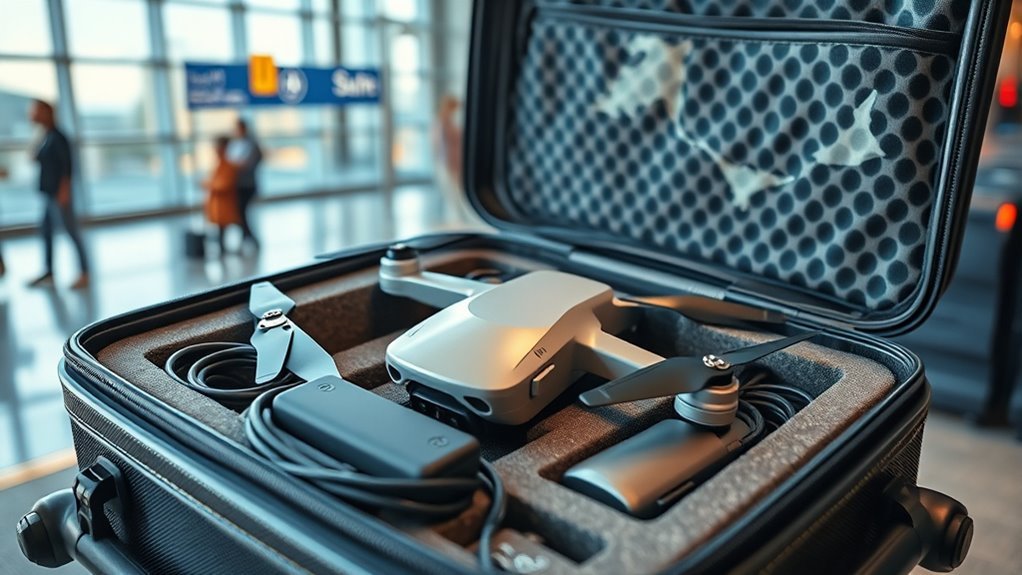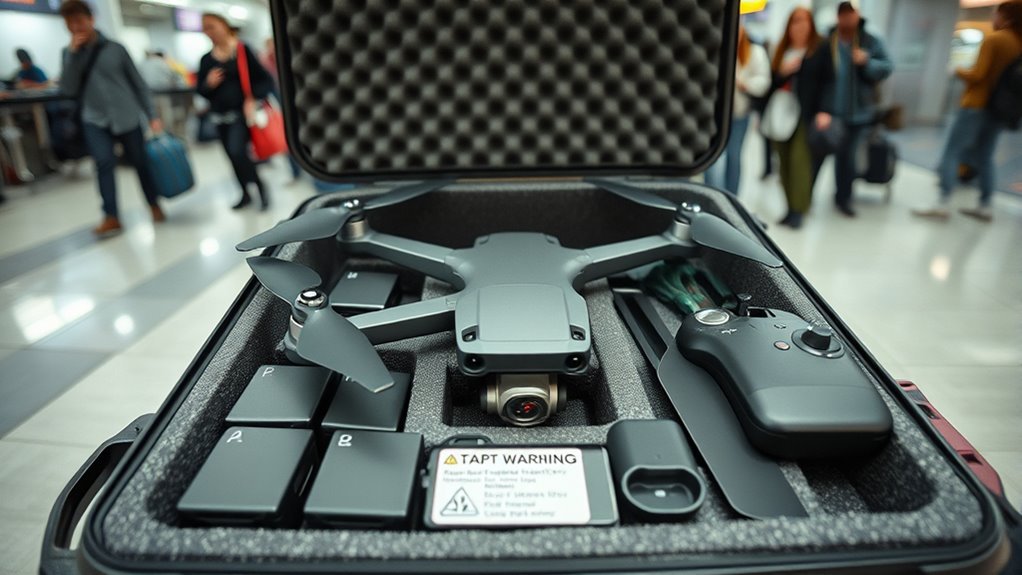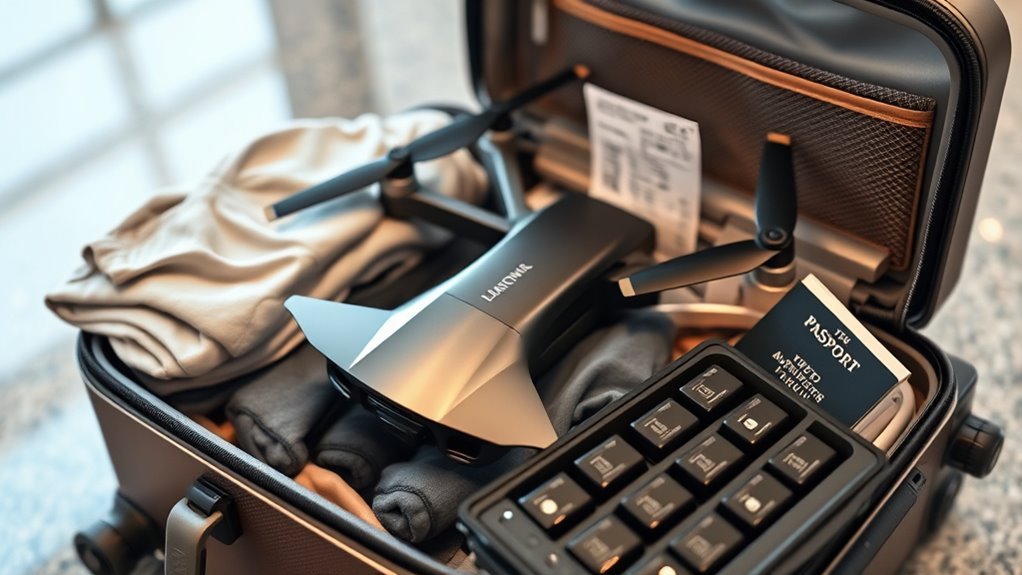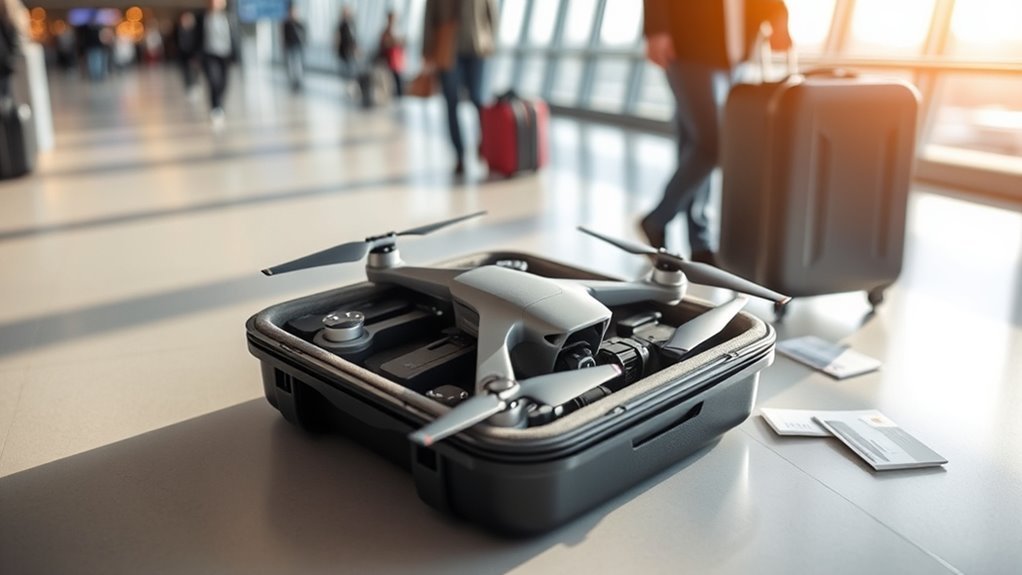To safely take your drone on an airplane, check airline regulations on size and weight limits. Pack your drone securely in a protective case and remove detachable parts. Always carry batteries in your carry-on, as larger LiPo batteries may need special approval. At security, take your drone out for screening. Finally, familiarize yourself with local drone laws at your destination to avoid any issues. There’s more to contemplate to guarantee a smooth experience.
Check Airline Regulations

Before you head to the airport with your drone, it’s essential to check the airline regulations, as each carrier has its own rules regarding the transport of drones. Start by confirming the acceptable drone size and weight limits. Many airlines have specific requirements, and exceeding these can lead to complications. Typically, drones under a certain weight may be allowed in carry-on luggage, while heavier ones might need to be checked. Additionally, some airlines restrict the battery size, so verify that your drone complies. Knowing these details helps guarantee a smooth journey, letting you focus on capturing stunning aerial shots at your destination. Stay informed, and you’ll enjoy the freedom to explore with your drone in tow.
Pack Your Drone Properly

To guarantee your drone arrives safely at your destination, it’s essential to pack it properly. Start by investing in a high-quality protective casing designed for drone storage. This will shield your drone from bumps and shocks during transit. Remove any detachable parts, like propellers, to minimize space and avoid damage. Wrap these components in soft materials, ensuring they’re secure within the casing. Make sure your drone is snugly packed to prevent movement within the case. If you’re traveling with batteries, keep them separate and follow airline regulations regarding battery storage. Finally, don’t forget to label your case clearly for easy identification. With proper packing, you’ll enjoy peace of mind and focus on your adventures ahead.
Understand Battery Restrictions

While you might be enthusiastic to take your drone on your travels, understanding battery restrictions is vital for a hassle-free experience. Most airlines allow lithium polymer (LiPo) batteries, but be aware of their specific battery types and charging limits. Typically, batteries over 100 watt-hours (Wh) need special approval, and those exceeding 300 Wh are usually prohibited. It’s important to check your drone’s battery specifications and verify they comply with airline regulations. Carry your batteries in your carry-on luggage, as checked baggage is often restricted. Keeping spare batteries under the limits will give you the freedom to capture stunning aerial shots without unnecessary delays. Knowing these restrictions in advance will save you time and stress at the airport.
Know Airport Security Procedures
Maneuvering airport security with your drone can be straightforward if you know what to expect. At security checkpoints, you’ll need to remove your drone from your bag for airport screening. Place it in a separate bin, just like your laptop. Be prepared for additional inspection if your drone has a larger battery or unique parts. Familiarize yourself with TSA guidelines, as they can vary by airport. Keep your drone’s batteries in a carry-on, as checked luggage may pose risks. Always check the specific airport’s rules before you fly. By understanding these procedures, you’ll breeze through security, ensuring your drone is ready for your next adventure without unnecessary delays. Enjoy the freedom to explore with your drone!
Follow Local Drone Laws at Your Destination
After successfully traversing airport security, the next step is understanding the local drone laws at your destination. Each location has its own drone registration requirements, and you’ll want to guarantee you’re compliant to avoid penalties. Research whether you need to register your drone before flying it. Additionally, familiarize yourself with local flying restrictions, as certain areas may have specific no-fly zones or altitude limits. National parks, urban centers, and near airports often have stricter rules. Drone regulations can vary significantly across countries, reflecting local priorities, so it’s essential to check resources like government websites or local drone clubs for up-to-date information. By staying informed and respecting these regulations, you can enjoy the freedom of flying your drone while guaranteeing a smooth and hassle-free experience at your destination. Always remember to check for temporary flight restrictions to ensure compliance with local laws.
Frequently Asked Questions
Can I Fly My Drone at My Destination?
When you reach your destination, think of your drone as a bird ready to soar. However, you’ll need to check local laws and drone regulations—freedom in the skies comes with responsibilities. Stay informed!
What Happens if My Drone Is Damaged During Travel?
If your drone’s damaged during travel, it’s essential to have drone insurance. Taking proper travel precautions can minimize risks, but if something happens, your insurance may cover repairs or replacement, allowing you to maintain your freedom.
Are There Restrictions for Drone Accessories on Airplanes?
Yes, there’re restrictions for drone accessories on airplanes. You’ll need to comply with battery regulations, especially for lithium batteries, and be aware of accessory limitations to guarantee a hassle-free travel experience with your drone gear.
How Do I Declare My Drone at Customs?
Imagine traversing a maze of drone regulations. When declaring your drone at customs, you’ll need to present documentation, comply with customs procedures, and guarantee you’re aware of any applicable import taxes for a smooth experience.
Can I Bring My Drone in My Carry-On Bag?
Yes, you can bring your drone in your carry-on bag, provided it meets size restrictions. Just make sure the batteries comply with regulations; typically, lithium batteries under 100 watt-hours are allowed without special permissions.

